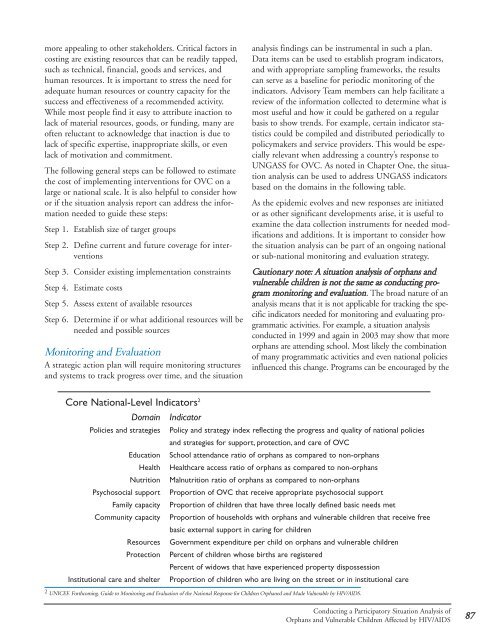Conducting a Participatory Situation Analysis of.pdf - Global HIV ...
Conducting a Participatory Situation Analysis of.pdf - Global HIV ...
Conducting a Participatory Situation Analysis of.pdf - Global HIV ...
Create successful ePaper yourself
Turn your PDF publications into a flip-book with our unique Google optimized e-Paper software.
more appealing to other stakeholders. Critical factors in<br />
costing are existing resources that can be readily tapped,<br />
such as technical, financial, goods and services, and<br />
human resources. It is important to stress the need for<br />
adequate human resources or country capacity for the<br />
success and effectiveness <strong>of</strong> a recommended activity.<br />
While most people find it easy to attribute inaction to<br />
lack <strong>of</strong> material resources, goods, or funding, many are<br />
<strong>of</strong>ten reluctant to acknowledge that inaction is due to<br />
lack <strong>of</strong> specific expertise, inappropriate skills, or even<br />
lack <strong>of</strong> motivation and commitment.<br />
The following general steps can be followed to estimate<br />
the cost <strong>of</strong> implementing interventions for OVC on a<br />
large or national scale. It is also helpful to consider how<br />
or if the situation analysis report can address the information<br />
needed to guide these steps:<br />
Step 1. Establish size <strong>of</strong> target groups<br />
Step 2. Define current and future coverage for interventions<br />
Step 3. Consider existing implementation constraints<br />
Step 4. Estimate costs<br />
Step 5. Assess extent <strong>of</strong> available resources<br />
Step 6. Determine if or what additional resources will be<br />
needed and possible sources<br />
Monitoring and Evaluation<br />
A strategic action plan will require monitoring structures<br />
and systems to track progress over time, and the situation<br />
analysis findings can be instrumental in such a plan.<br />
Data items can be used to establish program indicators,<br />
and with appropriate sampling frameworks, the results<br />
can serve as a baseline for periodic monitoring <strong>of</strong> the<br />
indicators. Advisory Team members can help facilitate a<br />
review <strong>of</strong> the information collected to determine what is<br />
most useful and how it could be gathered on a regular<br />
basis to show trends. For example, certain indicator statistics<br />
could be compiled and distributed periodically to<br />
policymakers and service providers. This would be especially<br />
relevant when addressing a country’s response to<br />
UNGASS for OVC. As noted in Chapter One, the situation<br />
analysis can be used to address UNGASS indicators<br />
based on the domains in the following table.<br />
As the epidemic evolves and new responses are initiated<br />
or as other significant developments arise, it is useful to<br />
examine the data collection instruments for needed modifications<br />
and additions. It is important to consider how<br />
the situation analysis can be part <strong>of</strong> an ongoing national<br />
or sub-national monitoring and evaluation strategy.<br />
Cautionary note: A situation analysis <strong>of</strong> orphans and<br />
vulnerable children is not the same as conducting program<br />
monitoring and evaluation. The broad nature <strong>of</strong> an<br />
analysis means that it is not applicable for tracking the specific<br />
indicators needed for monitoring and evaluating programmatic<br />
activities. For example, a situation analysis<br />
conducted in 1999 and again in 2003 may show that more<br />
orphans are attending school. Most likely the combination<br />
<strong>of</strong> many programmatic activities and even national policies<br />
influenced this change. Programs can be encouraged by the<br />
Core National-Level Indicators 2<br />
Domain Indicator<br />
Policies and strategies Policy and strategy index reflecting the progress and quality <strong>of</strong> national policies<br />
and strategies for support, protection, and care <strong>of</strong> OVC<br />
Education School attendance ratio <strong>of</strong> orphans as compared to non-orphans<br />
Health Healthcare access ratio <strong>of</strong> orphans as compared to non-orphans<br />
Nutrition Malnutrition ratio <strong>of</strong> orphans as compared to non-orphans<br />
Psychosocial support Proportion <strong>of</strong> OVC that receive appropriate psychosocial support<br />
Family capacity Proportion <strong>of</strong> children that have three locally defined basic needs met<br />
Community capacity Proportion <strong>of</strong> households with orphans and vulnerable children that receive free<br />
basic external support in caring for children<br />
Resources Government expenditure per child on orphans and vulnerable children<br />
Protection Percent <strong>of</strong> children whose births are registered<br />
Percent <strong>of</strong> widows that have experienced property dispossession<br />
Institutional care and shelter Proportion <strong>of</strong> children who are living on the street or in institutional care<br />
2 UNICEF. Forthcoming. Guide to Monitoring and Evaluation <strong>of</strong> the National Response for Children Orphaned and Made Vulnerable by <strong>HIV</strong>/AIDS.<br />
<strong>Conducting</strong> a <strong>Participatory</strong> <strong>Situation</strong> <strong>Analysis</strong> <strong>of</strong><br />
Orphans and Vulnerable Children Affected by <strong>HIV</strong>/AIDS<br />
87















